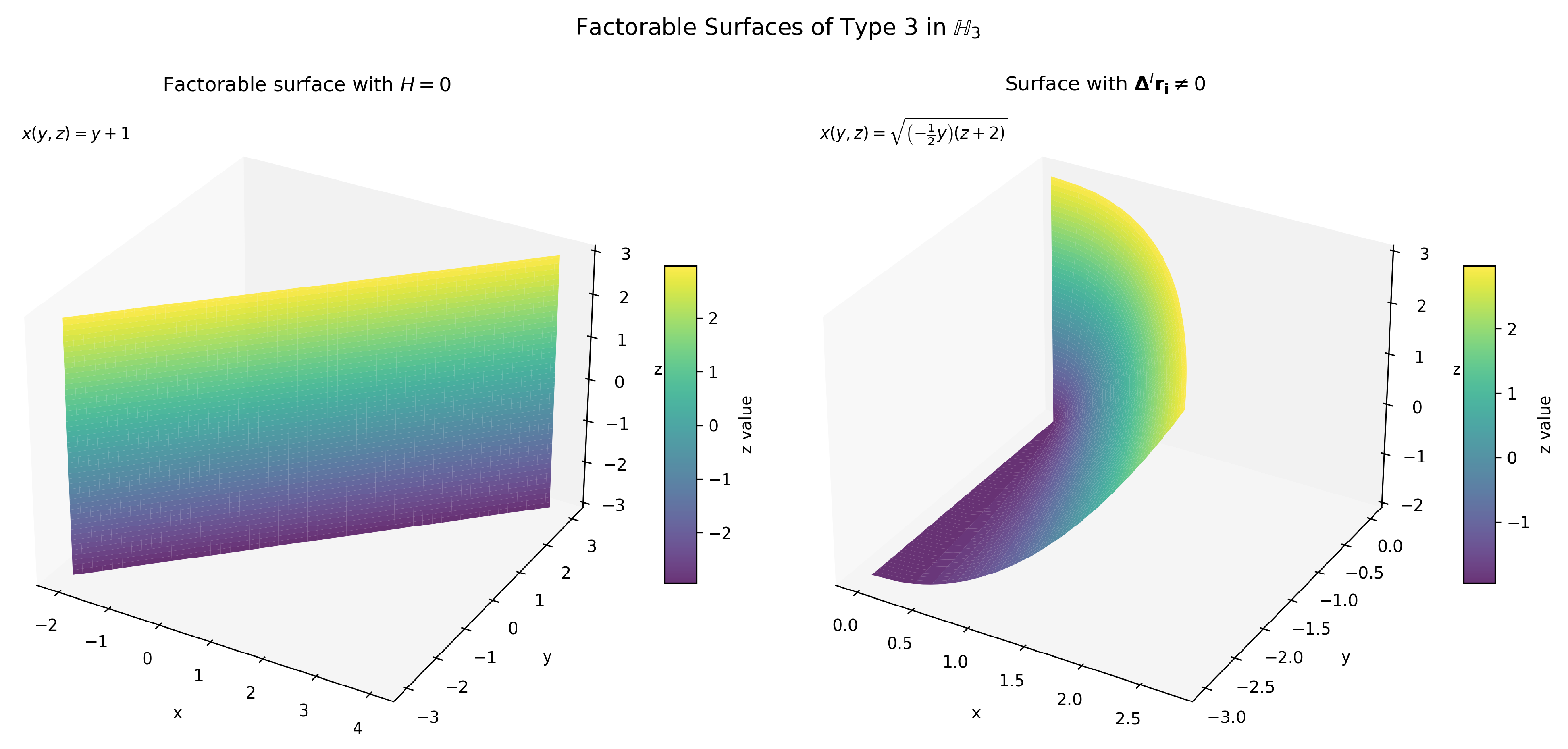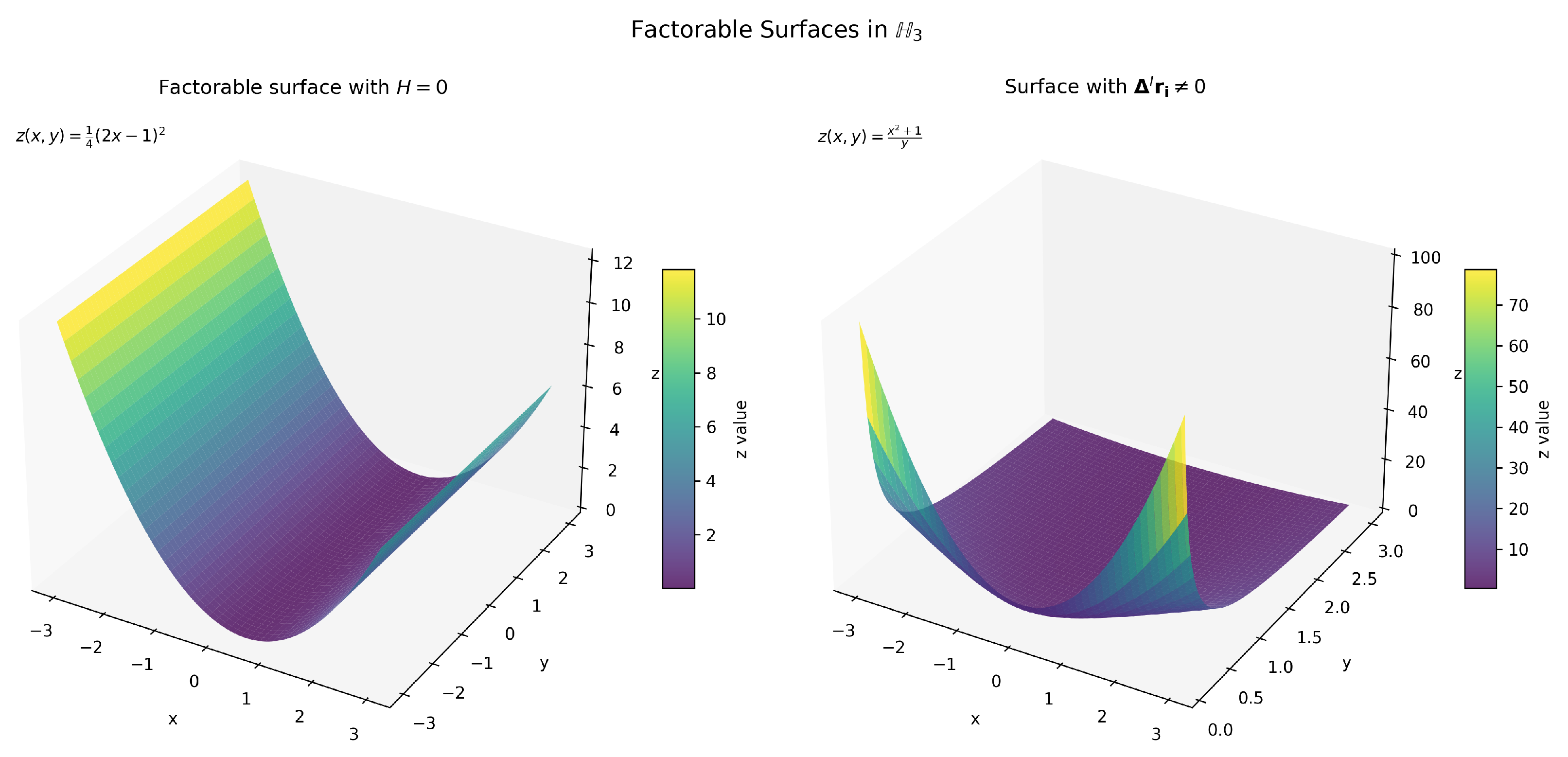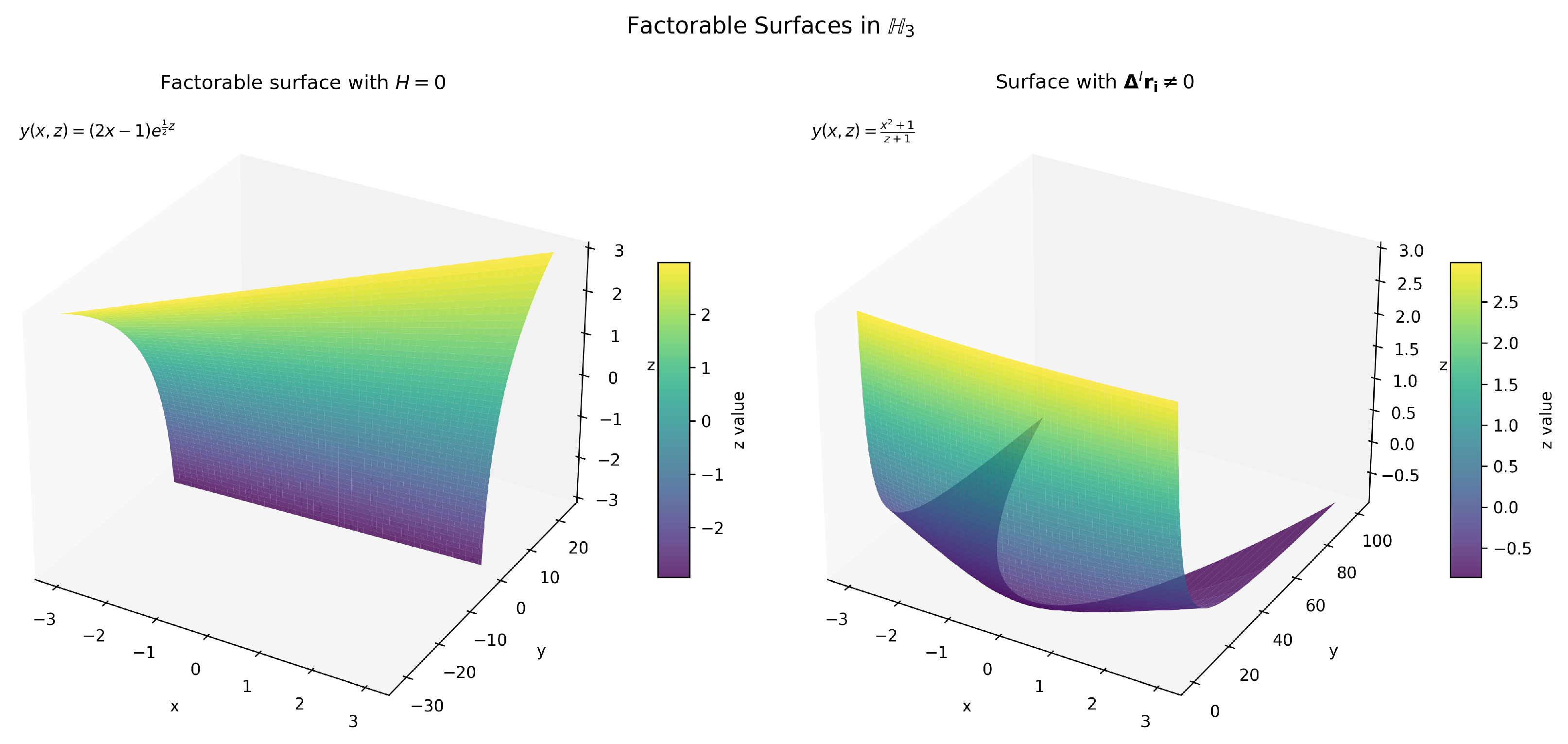On Factorable Surfaces of Finite Chen Type in the Lorentz–Heisenberg Space
Abstract
1. Introduction
2. The Beltrami Formula
3. Factorable Surfaces in
3.1. The First Type of Factorable Surfaces
3.2. The Second Type of Factorable Surfaces
3.3. The Third Type of Factorable Surfaces
4. Factorable Surfaces of the First Type Satisfying
- Case A:
- If , then , and the surface is minimal. From (26), a sufficient condition for this isThis leads to the following sub-cases:
- Case A.1:
- If , then . Substituting into (50), we obtain , so . Thus, the surface is parameterized aswhere and
- Case A.2:
- If , then . From (50), we deriveSolving (51) yieldsThus, the surface is parameterized aswhere and
- Case A.3:
- If , then , where . Substituting into (50), we obtainWe consider two sub-cases:
- Case A.3.1:
- Since and , this impliesthusTherefore, the surface is parameterized aswhere and
- Case A.3.2:
- The left-hand side of (57) is a function of y, while the right-hand side is a function of x. This leads to contradiction.
- Case A-4:
- Case A.4.1:
- Case A.4.2:
- Case A.4.2.1:
- If this is Case A.4.1, where
- Case A.4.2.2:
- If and then the following system of ODEs is obtained:
- Case A.4.2.3:
- If from (64), we obtainSince the right-hand side of (72) depends on y while the left-hand side depends only on x or is constant, we reach a contradiction.
- Case A-5:
- Case A.5.1:
- If from (73) we haveSince the left side of (74) is a function of x and the right side is a function of y, both sides have to be equal to a non-zero constant, which meansthen which is not possible.
- Case A.5.2:
- Case A.5.2.1:
- If this is Case A.5.1, where
- Case A.5.2.2:
- If and from (77), we haveand we obtain the same case as Case A.5.1.
- Case A.5.2.3:
- If from (77) we obtainthen which is impossible.
- Case B:
- Let ; the last equation in (49) becomesTo find solutions to Equation (82), we distinguish two cases based on the values of :
- Case B.1:
- Let , the last equation in (82) becomesWe will now look at the following sub-cases:
- Case B.1.1:
- If we haveAfter simplifying, we findSince the equation g has a variable y that is independent of x, we get a contradiction.
- Case B.1.2:
- If , , and , where a is not zero, then we haveTaking the partial derivative of (83) with respect to x twice yieldsfrom which the general solution to the equation is
- Case B.1.3:
- If we haveSince the equation f has a variable x that is independent of y, we get a contradiction.
- Case B.1.4
- If and where is not zero, then we havesoTaking the partial derivative of (85) with respect to y twice yieldsWe have to consider two cases.
- Case B.1.4.1
- If , , where
- Case B.1.4.2.
- If , we find a contradiction.
- Case B.2:
- The last equation in (87) becomesSince the left side of (88) is a function of x and the right side is a function of y, both sides have to be equal to a non-zero constant, i.e.,Therefore, we find the solutions of Equation (89):where and
- 1.
- has zero mean curvature.
- is a part of a plane in and parameterized by
- is parameterized by
- is parameterized by
where and - 2.
- is parameterized by
- 3.
- is parameterized by
- 1.
- Consider factorable surfaces of type 1 in with given by
- 2.
- Consider factorable surfaces of type 1 in with given by
5. Factorable Surfaces of the Second Type Satisfying
- Case C:
- If , we consider condition , which implies that f and h are constant. This leads to a contradiction (), implying . Therefore, the surface is minimal. From Equation (34), we obtainWe now examine the following sub-cases:
- Case C.1.
- When , we consider two distinct possibilities.
- Case C.1.1.
- Case C.1.2.
- If so then Equation (100) is trivially satisfied for all smooth functions Hence, we obtain
- Case C.2.
- Case C.3.
- If so with then, from (100) we obtainTaking the partial derivative of (105) with respect to z givesthus which is a particular case of Case C.1.1.
- Case C.4.
- If , we putwherefrom (107), (100) and (31), we can easily check that (100) is verified if and only ifTherefore, we have or
- Case C.4.1.
- Case C.4.2.
- If ℜ ∈ , which implies that there exist such that
- Case C.4.2.1.
- If this reduces to Case C.4.1, where , which is not possible.
- Case C.4.2.2.
- If and we obtain the following system of ODEs:Taking the partial derivative of (118) with respect to z gives . Thus this case is not possible.
- Case C.4.3.
- If and we obtain the following system of ODEs:Combining (123) with (124) yieldsand taking the partial derivative of (125) with respect to z givesTaking the partial derivative of (125) with respect to x gives , which is not possible.
- Case C.4.4.
- Case C.4.4.1.
- Case C.4.4.2.
- If , from (128) we obtainThe right-hand side of (133) depends on z, while the left-hand side is either constant or depends on x. For the equation to hold, both sides must equal the same non-zero constant; thus,then we get
- Case D:
- For or , we find . We distinguish the following cases:
- Case D-1.
- and . Thus, , where . Substituting into (99), we obtainFor this to hold for all x, the coefficients must vanish:The first condition implies , which contradicts the second condition (). Thus, this case is impossible.
- Case D-2.
- and . Then we have We find where Then we have which gives a contradiction.
- Case D-3.
- Integration of the two equations into (145) leads to and where .This leads to the following theorem:
- 1.
- has zero mean curvature.
- (a)
- is parameterized by
- (b)
- is parameterized by
- 2.
- is parameterized by ,
- 1.
- Consider factorable surfaces of type 2 in with given by
- 2.
- Consider factorable surfaces of type 2 in with given by
6. Factorable Surfaces of the Third Type Satisfying
- Case E:
- Case E-1:
- Case E.1.1.
- If from (156), there exist such that then the surface is parameterized as
- Case E.1.2.
- Case E.1.2.1.
- If this is Case E.1.1, where
- Case E.1.2.2.
- Case E.1.2.3.
- Case E-2:
- If so Equation (153) is trivially satisfied for all smooth functions and we have
- Case E-3:
- Case E.3.1.
- If from (166), there exist such that then the surface parameterized as
- Case E.3.2.
- Case E.3.2.1.
- If this is Case E.3.1, where
- Case E.3.2.2.
- If and from (170) we obtainThe right-hand side of (171) is a function of y, whereas the left-hand side is either a constant or a function of z. This leads to a contradiction.
- Case E.3.2.3.
- Case E.3.4.
- Case E.4.1.
- If from (176) we have this is the (Case E.1.).
- Case E.4.2.
- Case E.4.2.1.
- If this is Case E.4.1, where
- Case E.4.2.2.
- Case E.4.2.3.
- Case E.5.
- Case E.5.1.
- If Equation (186) becomesThe right side in (188) is either a function of z while the other side is a constant or a function of both sides have to equal a non-zero constant, namelytherefore , leading to a contradiction.
- Case E.5.2.
- Case E.5.2.1.
- If and from (192), we obtainSince the left-hand side of the equation is a function of y and the right-hand side is a function of z, both sides must equal a non-zero constant, such thattherefore , this leads to a contradiction.
- Case E.5.2.2.
- Case F.
- We discuss two sub-cases based on the values of
- Case F.1.
- Let , then we have This solution gives a contradiction.
- Case F.2.
- Let . From (197) we haveSince the left side of (198) is a function of y and the right side is a function of z, both sides have to be equal to a non-zero constant, that isSolving (199), we obtainwhere and
- 1.
- has zero mean curvature.
- (a)
- is parameterized by
- (b)
- is parameterized by .
- (c)
- is parameterized by
- 2.
- is parameterized by .
- 1.
- A minimal surface () with linear dependence on y:
- 2.
- A surface with non-vanishing exhibiting square-root dependence:

7. Conclusions
Author Contributions
Funding
Data Availability Statement
Conflicts of Interest
References
- Chen, B.-Y. Total Mean Curvature and Submanifolds of Finite Type; World Scientific: Singapore, 1984. [Google Scholar]
- Takahashi, T. Minimal immersions of Riemannian manifolds. J. Math. Soc. Jpn. 1966, 18, 380–385. [Google Scholar] [CrossRef]
- Yoon, D.W. Some classification of translation surfaces in Galilean 3-space. Int. J. Math. Anal. 2012, 6, 1355–1361. [Google Scholar]
- Medjahdi, B.; Zoubir, H. Affine factorable surfaces in the three-dimensional simply isotropic space. IAENG Int. J. Appl. Math. 2021, 51, 366–371. [Google Scholar]
- Medjati, R.; Zoubir, H.; Medjahdi, B. Classification of space-like translation surfaces in the 3-dimensional Lorentz Heisenberg group . Arab J. Math. Sci. 2023, 29, 154–171. [Google Scholar] [CrossRef]
- Rahmani, N.; Rahmani, S. Lorentzian geometry of the Heisenberg group. Geom. Dedicata 2006, 118, 133–140. [Google Scholar] [CrossRef]
- Chen, B.Y. Finite Type Submanifolds and Generalizations; Universita degli Studi di Roma La Sapienza, Istituto Matematico Guido Castelnuovo: Rome, Italy, 1985. [Google Scholar]
- O’Neill, B. Semi-Riemannian Geometry with Applications to Relativity; Pure and Applied Mathematics; Academic Press: New York, NY, USA, 1983. [Google Scholar]
- Bulca, S.B.; Dirim, T. Conchoidal Surfaces in Euclidean 3-space Satisfying Δxi=λixi. Univers. J. Math. Appl. 2023, 6, 114–121. [Google Scholar] [CrossRef]
- Meng, H.; Liu, H. Factorable surfaces in 3-Minkowski space. Bull. Korean Math. Soc. 2009, 46, 155–169. [Google Scholar] [CrossRef]
- Turhan, E.; Altay, G. Maximal and minimal surfaces of factorable surfaces in Heis3. Int. J. Open Probl. Comput. Sci. Math. 2010, 3, 200–212. [Google Scholar]
- Yu, Y.; Liu, H. The factorable minimal surfaces. In Proceedings of the Eleventh International Workshop on Differential Geometry; Kyungpook National University: Taegu, Republic of Korea, 2007; pp. 33–39. [Google Scholar]


Disclaimer/Publisher’s Note: The statements, opinions and data contained in all publications are solely those of the individual author(s) and contributor(s) and not of MDPI and/or the editor(s). MDPI and/or the editor(s) disclaim responsibility for any injury to people or property resulting from any ideas, methods, instructions or products referred to in the content. |
© 2025 by the authors. Licensee MDPI, Basel, Switzerland. This article is an open access article distributed under the terms and conditions of the Creative Commons Attribution (CC BY) license (https://creativecommons.org/licenses/by/4.0/).
Share and Cite
Medjahdi, B.; Medjati, R.; Zoubir, H.; Belhenniche, A.; Chertovskih, R.
On Factorable Surfaces of Finite Chen Type in the Lorentz–Heisenberg Space
Medjahdi B, Medjati R, Zoubir H, Belhenniche A, Chertovskih R.
On Factorable Surfaces of Finite Chen Type in the Lorentz–Heisenberg Space
Medjahdi, Brahim, Rafik Medjati, Hanifi Zoubir, Abdelkader Belhenniche, and Roman Chertovskih.
2025. "On Factorable Surfaces of Finite Chen Type in the Lorentz–Heisenberg Space
Medjahdi, B., Medjati, R., Zoubir, H., Belhenniche, A., & Chertovskih, R.
(2025). On Factorable Surfaces of Finite Chen Type in the Lorentz–Heisenberg Space





